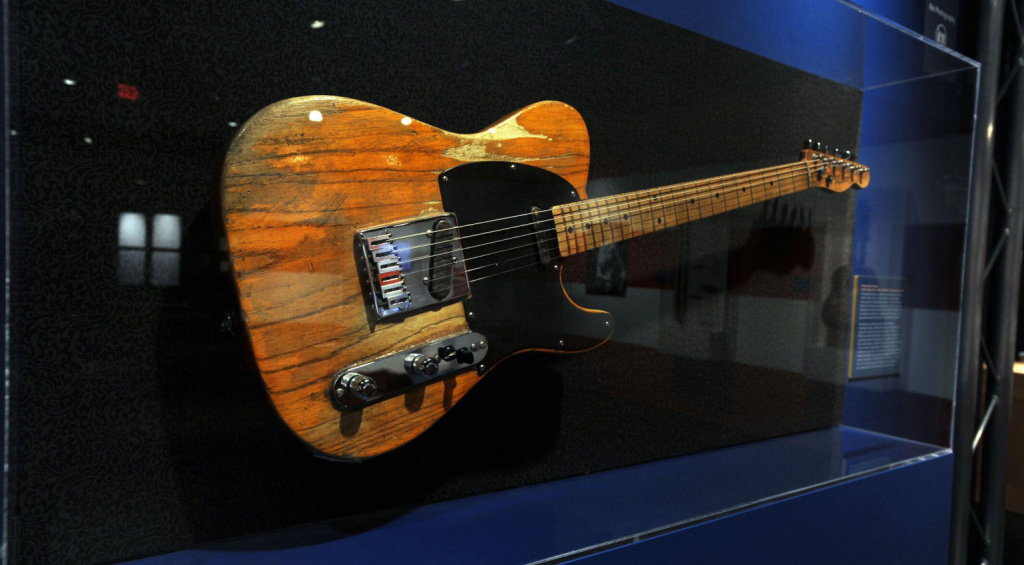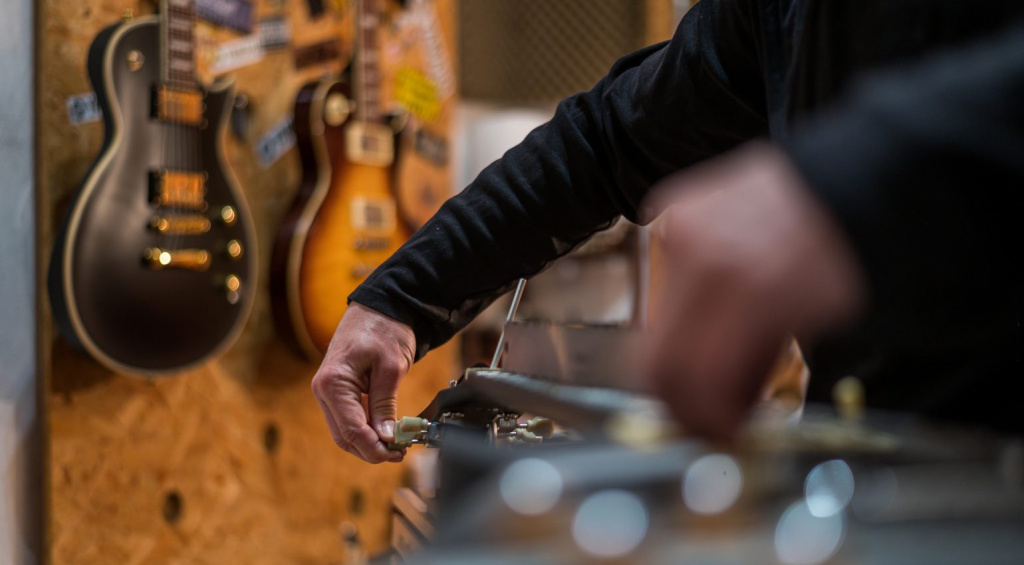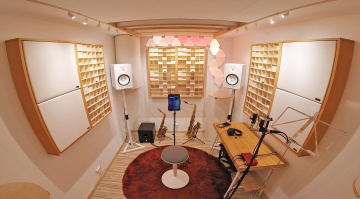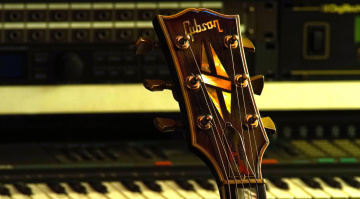Cryo-tuning – Hocus Pocus or Real Added Value?
The Benefits of Freezing Guitars
Cryo-tuning sounds like high-end science for high-end guitarists. It involves treating wood at -185 °C, which is supposed to make it “calmer,” more resonant, and louder. It’s a process that hovers somewhere between materials science, marketing, and myth. While some swear their guitars sound more open, crisp, and stable after the treatment, others just shrug their shoulders. After all, much of what cryo-tuning promises has yet to be proven. However, as is often the case in the world of guitars, what feels better subjectively may ultimately be just right musically.
This article deals with two things: the practical question of what cryo-tuning can achieve and the psychological component that influences the experience of an instrument, which is equally crucial. After all, a guitarist’s perception of their instrument often changes simply by feeling that they are holding something special.
The Most Important Facts at a Glance
- Cryo-tuning involves deep-freezing guitar wood to around -185 °C, supposedly reducing tension and improving vibration behavior
- Claimed advantages, such as greater resonance, better sustain, and a vintage-like openness, are difficult to prove scientifically and show only minimal effects in tests
- However, the psychological influence has been proven: those who believe their instrument has been optimized often perceive it as sounding better and play with greater confidence
- While cryo-tuning offers no clear practical advantage for most guitarists, it can significantly change their perception of their playing and instrument
All About Cry-tuning
What is Cryo-tuning for Guitars, and How Does it Work?
Cryogenic treatment sounds like something you’d find in a laboratory involving nitrogen tanks and cyborgs, and indeed, these things are all used. At least, as far as I understand, there are no cyborgs involved.
The focus of cold treatment for guitars is on the wood of the instruments being treated. The wood is supposed to become “relaxed,” denser, and more structurally stable.
The process follows a fixed sequence: First, the wood is slowly cooled to temperatures as low as -185 °C over the course of many hours to prevent structural damage. Then, it remains in a controlled state and is reheated slowly and gradually.
The idea is that the extreme temperature reduces microscopic tensions in the cell structure. Some suppliers even talk about “realigned” wood fibers that are supposed to vibrate better.
It’s important to note that cryo-tuning is not the same as thermal treatments like roasted maple or torrefaction. These processes visibly and permanently alter the chemical composition of the raw material through heat and oxygen deprivation. Cryo-tuning, on the other hand, uses cold temperatures and promises subtle improvements that supposedly take place inside the material.
The key question, however, is: Can wood really sound “better” after a few hours in a freezer?
Why is Cryo-tuning Used?

Before determining the usefulness of cryo-tuning, it is worth taking a brief look at what fundamentally characterizes wood as a material for instruments.
Even when it has been part of an instrument for decades, wood is a living material. Moisture, pressure, temperature, and internal stresses continue to affect its rigidity, vibration behavior, and stability.
An old, well-played guitar with well-aged wood often feels more responsive. The neck moves less, the body vibrates more freely, and the sustain feels more natural. This “aging” process takes place over many years: the wood dries out, the cell structures relax, and the fibers settle into their new arrangement.
Cryo-tuning is supposed to act as a kind of turbo aging – a technical shortcut to a “more mature” tone. The idea is not entirely far-fetched, but whether these effects can be heard on an electric guitar is another question.
This brings us to a crucial point: Much of what cryo tuning is supposed to achieve is based on assumptions from other disciplines, not reliable data from guitar-making.
The Claimed Advantages of Cryo-treated Wood
Those who offer cryo-tuning often promise an impressive list of improvements. The most frequently mentioned are greater resonance, better vibration behavior, finer sustain, greater tuning stability, and an overall “vintage-like openness” reminiscent of instruments that have been played for decades.
The argument is simple: if the wood becomes calmer, it vibrates more freely and sounds “better.”
Guitar necks, in particular, are the focus of the treatment. Cryogenic treatment is said to make them more dimensionally stable, less susceptible to temperature and humidity fluctuations, and more uniform in transmitting string vibrations. Some suppliers even claim that the cold treatment gives the instrument “greater dynamics” and “faster response,” as if it had received a fresh “cell cure” in terms of sound.
Where do These Promises Come From?
Often, they come from areas only marginally related to guitar making, such as metalworking industries. In these industries, cryo treatments have demonstrable effects and are used to harden tools, for example.
However, it is difficult to transfer these results to tonewood because wood is an organic and much more complex material. What works in mechanical engineering cannot automatically be applied to the vibration behavior of a guitar neck.
Scientific Reality Check: What Can Really be Measured With Cryo-tuning?
As soon as you start looking for hard, objective data, you’ll find that it’s scarce. While thermal treatments using heat cause clear, reproducible changes (less moisture, higher hardness, and a darker color), the effects of cryo-tuning are much more subtle and often barely detectable.
Some of these effects can be measured in laboratory environments:
- Minimal changes in the hardness of certain wood fibers
- Slight differences in density and microstructure
- Slight reductions in internal tension
However, this is where the problem begins. While these measurements can be confirmed in a lab, they are so small that they are rarely musically relevant. Most tests show no significant changes. Additionally, guitar wood is a natural product. Each grain, annual ring, and growth process is unique. Unlike with industrially standardized steel for machine tools, “before and after” comparisons are statistically difficult to carry out accurately.
Therefore, the question is not so much: Does something happen? Rather, the question is: Does enough happen to be reliably heard in a guitar signal?
“Hear, hear,” some readers of my articles will say, “Suddenly, he’s so critical. Have we brought him back to the right path of science?!” Don’t worry: my point is coming. You are welcome to comment.
Why Cryo-tuning Can Still Work – Proven!
Even if the physical effects are minimal, the psychological impact of cryo-tuning can be enormous (the guitar, not the guitarist… although…). As guitarists, we are sensitive beings, often more so than we would like.
Every change to our instrument affects our experience: how the neck feels, how alive the wood seems, and how “special” the setup appears. These things cannot be measured, repeated, or considered empirically reliable. But they are important.
Three Things Play a Major Role Here:
Expectation bias
Anyone who optimizes an instrument and pays for it automatically expects an improvement. This expectation influences playing and listening. The brain filters sounds differently and perceives subtleties more strongly and positively. This is not a mistake, but human nature. It’s audible, just not measurable.
The feeling of value
“This wood was in a cryogenic tank” – that alone can build a deeper connection to an instrument. The owner plays more consciously, with greater concentration and higher expectations of themselves. This often creates the impression of a better tone.
Playing experience trumps measurements
A guitarist who feels more comfortable with their instrument will perform better. Regardless of whether the improved vibration exists objectively, a positive playing experience leads to better musical results because they are perceived more positively on a personal level. In practice, that’s what counts.
Therefore, the psychological factor is not a flaw – it is part of the truth. An instrument that feels “optimized” can sound better to its owner and increase motivation. So who cares about measurements?
Instead of Cryo-tuning: These Factors Make a Measurable Difference

If you’re looking for a real, measurable improvement in sound quality, you’ll almost always find it in well-documented, classic measures. No special chambers or nitrogen tanks are required. And no cyborgs. So, go for one of the following and enjoy it with your favorite drink on the rocks.
Setup
A professional setup changes the feel and sound of a guitar more dramatically than any cryogenic treatment. String action, neck curvature, and octave accuracy are where the real potential lies.
Fretwork
Cleanly dressed frets provide better sustain, more defined notes, and a significantly more comfortable playing experience. This area delivers noticeably better results than cryogenic techniques.
Pickup Height and Electronics Quality
A few millimeters in pickup height can have a greater impact than -185 degrees Celsius. Good-quality potentiometers, capacitors, and switches improve dynamics and assertiveness.
Saddle Material and Tuners
GraphTech saddles, well-lubricated bone saddles, and high-quality locking tuners ensure tremendous tuning stability. All of these factors are measurable. And audible.
String Selection and Material Combinations
Choosing the right strings for your style is important. The difference between pure nickel strings, steel cores, and different gauges is immediately noticeable in a direct comparison. This is unlike the effects of cryogenics.

FAQ About Cryo-tuning
What is cryo tuning for guitars?
It is the process of deep freezing tonewood, cooling necks and bodies to temperatures as low as -185 °C. This reduces internal tensions in the material and improves its vibration behavior.
Does cryo tuning improve the sound of an electric guitar?
In most cases, the effects are minimal and often only perceptible subjectively. Factors such as pickups, setup, fretwork, and strings have a significantly greater influence.
Is Cryo-tuning worthwhile for guitarists?
Not for most. The audible improvements are negligible, and established optimizations achieve significantly better results. Cryo-tuning is more of an optional “boutique feature.”
Can Cryo-tuning make the neck more stable?
Some players report slightly calmer material behavior, especially with very light or sensitive woods. However, there is no evidence of a significant gain in stability.
Cryo-tuning involves cooling guitar wood to extremely low temperatures to stabilize the material structure. Although cryo-tuning is advertised as offering advantages such as greater resonance, better sustain, and increased tuning stability, laboratory data and practical tests show that the effects are minimal and often not reproducible. The greatest effect often occurs on a subjective level: a guitarist convinced that they are playing an optimized instrument experiences a more intense playing feel and interprets the sound more positively. Therefore, cryo-tuning remains an interesting niche procedure without any clear, objectively verifiable sound advantages, but with possible psychological benefits.
Conclusion: Between Science, Myth, and the Musician’s Heart
Cryo-tuning sits at the intersection of technology and emotion. Objectively, the changes brought about by cryogenic treatments are minimal, difficult to measure, and mostly irrelevant from a musical perspective.
But subjectively? A guitarist who believes his instrument vibrates more freely may play differently. More confidently. More motivated. In the end, that’s what can make a real difference.
Cryo-tuning is not pure hocus-pocus, but it’s not a revolutionary breakthrough, either. It’s a method with some niche applications, but its main effect is on the experience of playing an instrument. And maybe that’s not such a bad thing. Ultimately, what happens in the nitrogen tank doesn’t matter. What matters is what happens in the guitarist’s head, hands, and ears. So, when is it your guitar’s turn?
*Note: This article contains affiliate links that help finance our site. Don’t worry—the price for you always remains the same! If you buy something through these links, we receive a small commission. Thank you for your support!
One response to “Cryo-tuning – Hocus Pocus or Real Added Value?”

 3,0 / 5,0 |
3,0 / 5,0 | 







As we see so often throughout the musical instrument retail business, fools and their money are easily parted.